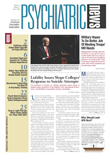Light therapy and fluoxetine both induced remissions in about half of patients with winter seasonal affective disorder (SAD)—even those who were severely depressed, Canadian researchers found in a double-blind, randomized, controlled trial.
Two-thirds of patients using either firstline treatment showed a clinical response, according to Raymond Lam, M.D., a professor of psychiatry and head of clinical neuroscience at the University of British Columbia, Vancouver. The results of the study, known as Can-SAD, were published in the May American Journal of Psychiatry.
While light therapy worked a little faster than fluoxetine and triggered slightly fewer patient-reported adverse events in two-month trials, subjects tolerated both treatments well. Absent clear superiority for either light or fluoxetine, patient preference should guide treatment selection, the researchers suggested.
“Patients often prefer light therapy, but physicians always wondered whether light was as good as drugs,” Lam told Psychiatric News.“ Now we have evidence to support the decision to use light as a first-choice treatment for patients with winter depression.”
The researchers compared the two therapies in 96 adults with SAD at four centers over three winter seasons, 2000-2001 through 2002-2003. Their eight-week treatment protocol is the longest controlled light therapy study to date. It also is the first to run as long as the standard clinical trial for an antidepressant.
All participants had moderate to severe depression, as indicated by the Structured Clinical Interview for DSM-IV and scores on Hamilton depression rating scales. None had previously used light therapy or fluoxetine. No subjects were currently taking other psychotropic medications, and none had engaged in formal psychotherapy for three months prior to the study or while participating in it.
The researchers randomly assigned 48 eligible subjects to receive active light therapy plus placebo capsules, and 48 to receive placebo light therapy plus fluoxetine.
Subjects on active light therapy received daily exposure to 10,000 lux light for 30 minutes as soon as possible after they awakened— the now-standard treatment. The placebo light therapy utilized dim light of only 100 lux on the same schedule. To minimize expectation bias, researchers told patients that the study aimed to examine different wavelengths of light without mentioning intensities.
Subjects receiving active medication took 20 mg of fluoxetine in a single daily dose between 7 a.m. and 8 a.m. The identical placebo capsule taken at the same time of day had an inert filler.
Board-certified psychiatrists, blinded to treatment assignments, assessed patient response using a variety of Hamilton depression scales. For the study, the researchers defined clinical response as a 50 percent or greater reduction in baseline in 24-item Hamilton depression scale scores at the last visit. They defined clinical remission as a clinical response plus a score of 8 or less.
Researchers monitored adverse effects using a self-rated patient scale that assesses frequency and severity of 32 adverse events. This scale provides a broader and more systematic picture than spontaneous self-reports.
Forty subjects in the active light treatment group and 40 in the active fluoxetine treatment group completed the study, with the majority improving in all measures over time. The response and remission rates for both active treatments were similar in magnitude to those reported in other placebo-controlled trials.
Rates of many adverse events, despite intensive reporting, were lower than 5 percent for both light and fluoxetine treatment.
At baseline, the researchers found no differences in expectations for light or drug between subjects assigned to either group. Overall, subjects had higher expectations for light over drug, although not for one light condition over the other.
A grant from the Canadian Institutes of Health Research (CIHR) and a CIHR/Wyeth postdoctoral fellowship to one of the researchers funded the study. Up-lift Technologies supplied the light boxes.
